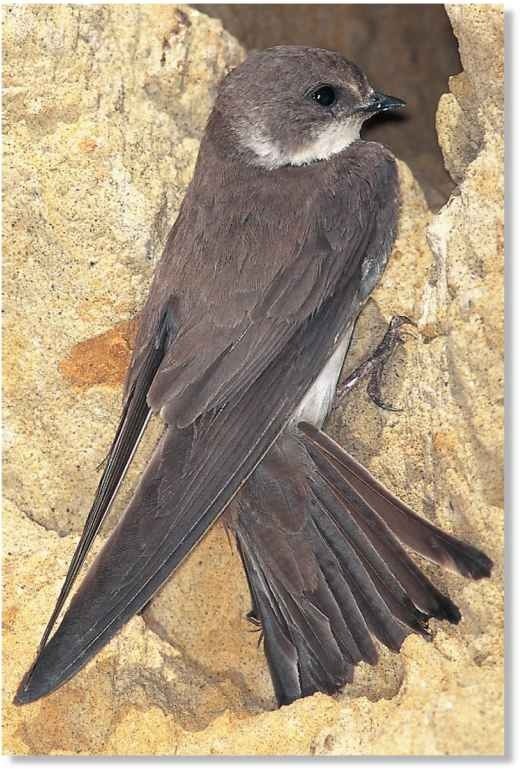ORDER
Passeriformes
FAMILY
Hirundinidae
GENUS & SPECIES
KEY FEATURES
• Spends most of its | life in the air, darting in light, aerobatic flight
• Feeds mainly on flying insects, which it catches on the wing
• Nests in steep, sandy banks, excavating a breeding tunnel that may be up to 3′ deep
• Migrates thousands of miles between the Southern and Northern Hemispheres each year
WHERE IN THE WORLD?
Found in the summer throughout temperate regions of North America, Europe and Asia, including parts of China; spends winter months in South America, Africa and parts of central Asia

Lifecycle
The bank swallow lives almost entirely in the air, wheeling and dipping as it chases its tiny insect prey. Only in the breeding season does it spend part of the time on the ground.
HABITAT
The bank swallow prefers open country, often near streams, rivers and lakes, where it has space to fly in pursuit of insects. It needs trees, bushes or man-made perching places to rest on, but tends to avoid thick woodland, built-up areas, highlands and dry regions.
In summer breeding seasons, the bank swallow’s habitat is determined by the presence of soft, sandy banks in which it builds nesting burrows. It’s now found near riverbanks, earth cliffs and old sand pits.

A Ready to go Swallows gather on wires before autumn migration.
Colonial living Breeding bank swallows often tunnel in sandbanks.

FOOD & FEEDING
The swallow feeds on flying insects, especially flies, catching them by swooping down with an open bill. It sometimes eats grasshoppers, dragonflies and beetles. The bank swallow also drinks while in flight by flying close to the water and scooping it up in the lower half of its bill.
When there are young to be fed, the adults fly in frequent food-gathering missions — more than ten per hour — and they catch most insects in the late morning and afternoon.
On average, a brood of young bank swallows may be brought as many as 7,000 insects by their parents in the course of a single day.
CONSERVATION
The western European bank swallow population has fallen by 90% owing to a series of droughts in its African wintering quarters.
Skydiving The agile bank swallow can easily out-fly its insect prey.
Aristotle mistakenly thought bank swallows hibernated underwater — perhaps because they collect in large numbers in reedbeds before migrating.
Roosting flocks with over a million bank swallows may gather in preparation of migrating.
In periods of high winds or prolonged heavy rain, the bank swallow faces lean times, as few insects can take to the wing. However, it’s capable of surviving up to 21 days on its fat reserves alone.
BEHAVIOR
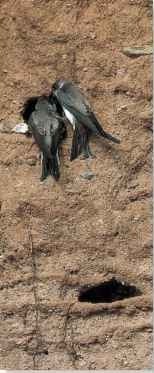
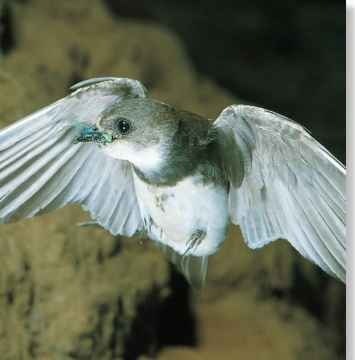
Like its swallow relatives, the bank swallow is highly social, spending most of its time flying in flocks and keeping in touch by constant twittering. If one bird senses danger; it alerts the rest of the flock by making a short, sharp “brrit” sound.
Most bank swallows migrate south in the fall when colder weather kills off many flying insects. Flocks follow the same route every year; flying by day and roosting together at night.
When the bank swallow returns north in spring, the older and more experienced birds arrive 3 weeks ahead of young birds making the journey for the first time, the males returning before the females.
Bank swallow city Prime nesting sites may attract many swallows, so pairs space their holes far enough apart to prevent squabbles.
BREEDING
Since male bank swallows return to breeding grounds before females, they take up residence in old nesting burrows or begin to dig new ones. The male digs about I 2″ of a new tunnel, then tries to attract a female by singing and flying with fast wingbeats at the entrance. If he’s successful, the pair mates and the birds finish the tunnel together
The 4-6 eggs hatch in 14 days; the young are featherless and blind. For the first few days, one of the parents cares for them almost continuously Young develop quickly and by 14 days can scramble to the entrance of the tunnel to defecate. At 4-5 weeks old, the young swallows are ready to leave the nest and fend for themselves. Early-nesting adults may rear a second clutch of eggs.

A Feather down The nest is lined with feathers, grass and leaves.
SHARING THE CARING
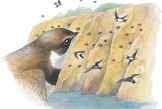
1 Home again…
In spring, the male returns from the south to a nesting site. Good sites in a steep bank of sandy earth are used every year.
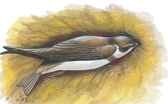
2 Tunnel…
When the female joins the male, they take turns to dig. A new tunnel may progress about 4″ a day and take a week to complete.
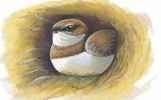
3 Chamber…
Eggs are laid at the end of the tunnel in a small chamber about 2-2.5″ in diameter. Both parents share incubation duties.
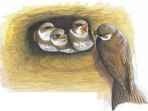
4 Hatched
After hatching, the young are fed by both adults on a diet of small insects.They grow quickly and fledge after 22 days.
Profile
Barn Swallow
Long, streamlined wings and a forked tail give the bank swallow a fast, buoyant flight and the maneuverability to catch flying insects.
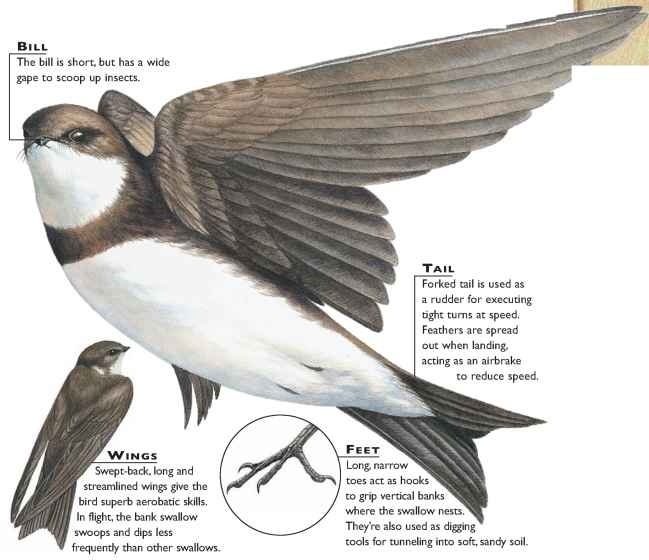
CREATURE COMPARISONS
Two relatives often seen flying alongside the bank swallow are the barn swallow and tree swallow.The barn swallow is the largest. It also has the longest tail feathers and the most pointed wings.The tree swallow has less-curved wings and a deep-green back, while the bank swallow is distinguished by a breast band.
All feed on flying insects.The tree swallow tends to fly the highest, while the barn swallow hunts near the ground or over water.
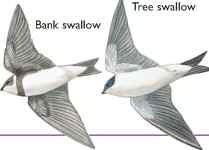
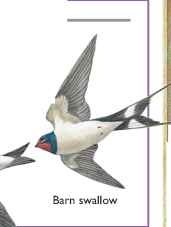
VITAL STATISTICS
Weight 0.4-0.5 oz.
| Length WlNGSPAN |
00 -fe 5 |
| Sexual Maturity | 1 year |
| Breeding Season | May-July |
| Number of Eggs | 4-6 |
| Incubation Period | 14-15 days |
| Fledging I Period | 22 days |
| Breeding Interval | 2 clutches a year (average) |
| Typical Diet | Small flying insects |
| Lifespan | Up to 9 years |
RELATED SPECIES
• The sand martin (or bank swallow) belongs to the family Hirundinidae, which has 80 species. This family is part of the largest order of birds, Passeriformes, which has nearly 6,000 species (about 60% of all the known bird species). In this order, the sand { martin belongs to the suborder Oscines, which I includes relatives such as I larks, thrushes, sparrows, flycatchers and tits.
